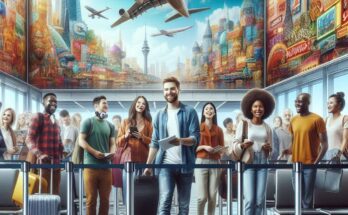Introduction to Air Travel in the US
Traveling by air across the United States is a popular choice due to its convenience and speed, especially given the country’s vast size. From bustling cities to remote locations, air travel offers an efficient way to reach your destination. With a variety of airlines and flight routes, you can customize your journey to match your preferences and budget.

Airports in the US are equipped with modern facilities and services to accommodate the needs of millions of passengers annually. Whether you need a quick bite before your flight or want to relax in a lounge, most airports have plenty of amenities to keep you comfortable. Additionally, many airports are well-connected to public transportation and offer numerous rental car options, making it easier to continue your journey upon arrival.
Choosing the right airline can significantly impact your travel experience. Some airlines are known for their extensive route networks, while others might offer unique perks like free checked bags or extra legroom. It’s important to compare airlines to find the one that best suits your needs. Booking your flights in advance and keeping an eye on fare comparison websites can help you secure the best deals.
Security procedures are a critical aspect of air travel in the US. The Transportation Security Administration (TSA) has specific guidelines to ensure the safety of all passengers. Being aware of these procedures and preparing accordingly can help you navigate the security screening process more efficiently. Arriving early at the airport and having your documents ready can save you valuable time and reduce stress.
Whether you’re flying for business or leisure, understanding the nuances of air travel in the US can greatly enhance your experience. From selecting the right airline to navigating airport facilities and security procedures, being well-informed can make your journey smoother and more enjoyable.
Major Airports in the US
The United States boasts some of the busiest and most well-equipped airports in the world. Hartsfield-Jackson Atlanta International Airport in Georgia consistently ranks as one of the top in terms of passenger traffic. With extensive domestic and international flight options, it serves as a crucial hub for travelers. Los Angeles International Airport in California, known for its expansive layout and modern amenities, offers numerous shopping and dining options to keep travelers entertained during layovers.
Chicago O’Hare International Airport in Illinois is another major gateway, featuring a wide range of services, including lounges, duty-free shops, and various dining establishments. This airport also serves as a key connecting point for flights across the Midwest and beyond. John F. Kennedy International Airport in New York stands out for its diverse international connections and high-end amenities, catering to millions of passengers each year.
In addition to these, Denver International Airport in Colorado is notable for its unique architectural design and extensive network of domestic routes. Orlando International Airport in Florida attracts a large number of tourists heading to the state’s popular theme parks and resorts. Miami International Airport serves as a vital hub for flights to and from Latin America and the Caribbean, offering a rich variety of cultural experiences and dining options.
Seattle-Tacoma International Airport in Washington provides excellent services for travelers heading to the Pacific Northwest and Asia. San Francisco International Airport in California offers numerous flights to Asia and Europe, complemented by a variety of amenities and efficient public transportation links.
These airports are not only gateways to various destinations but also hubs of activity and convenience, providing travelers with essential services and amenities. From efficient public transportation links to diverse dining and shopping options, these major airports are designed to enhance the travel experience for millions of passengers each year.
Navigating Security Procedures
Navigating security procedures at US airports can be straightforward if you know what to expect. The TSA requires passengers to go through several steps to ensure safety. First, you’ll need to present your boarding pass and ID at the checkpoint. Make sure both are easily accessible to avoid delays.

When it comes to your belongings, you will need to place them in bins provided at the checkpoint. Laptops and other electronic devices larger than a cellphone must be removed from your carry-on and placed in separate bins. Similarly, shoes, belts, and jackets need to be taken off and placed in bins. Liquids, gels, and aerosols are allowed in carry-on bags but must be in containers of 3.4 ounces or less and placed in a quart-sized, clear plastic bag.
For those traveling with children, note that children under the age of 12 can keep their shoes on. Baby formula, breast milk, and baby food are allowed in reasonable quantities exceeding 3.4 ounces and do not need to be placed in a quart-sized bag, but they must be declared for inspection at the checkpoint.
Certain items are prohibited in both carry-on and checked bags. These include firearms, explosives, and certain types of tools and sporting equipment. A comprehensive list of prohibited items is available on the TSA website, and reviewing it before you pack can save you from unnecessary hassle.
If you have medical conditions or disabilities that may affect your screening, inform the TSA officer before the process begins. They are trained to handle various situations and can offer alternative screening methods if necessary.
Lastly, consider enrolling in TSA PreCheck if you frequently travel within the US. This program allows expedited screening, letting you keep on your shoes, belts, and light jackets, and leave laptops and compliant liquids in your bag. By following these guidelines and being prepared, you can make your way through security efficiently and start your journey with less stress.
Airline Options and Ticketing
When it comes to air travel within the United States, you have multiple airline options, each with distinct features and services. Delta Air Lines stands out for its extensive network of both domestic and international routes, making it a reliable choice for frequent travelers. Southwest Airlines offers a more budget-friendly approach, with policies like free checked bags, which can make a big difference for families and budget-conscious travelers. United Airlines and American Airlines also provide comprehensive route networks and robust loyalty programs, which are great for those who travel often and want to accumulate miles for future benefits.
When booking flights, it’s essential to compare prices across different airlines to find the best deal. Fare comparison websites can be incredibly useful for this purpose, offering a straightforward way to see all your options in one place. Additionally, consider flexibility options like refundable tickets or travel insurance, which can provide peace of mind in case your plans change.
For those looking to maximize comfort or convenience, many airlines offer upgraded seating options, such as premium economy or business class. These seats often come with additional legroom, enhanced in-flight services, and priority boarding, making your travel experience more enjoyable.
Booking your flights well in advance can often result in better prices, especially during peak travel seasons. Keep an eye out for sales or special promotions, which airlines frequently offer to fill seats on less busy flights. Utilizing frequent flyer programs can also lead to significant savings and perks over time.
Remember to check the baggage policies of each airline, as they can vary and impact your overall travel cost. Some airlines charge for checked bags, while others include them in the ticket price, so factor this into your budget when making your decision.
Understanding Flight Delays and Cancellations
Flight delays and cancellations are an unfortunate reality of air travel. Common reasons include weather conditions, technical issues, and air traffic congestion. If your flight is affected, the first step is to stay informed by checking your airline’s app or website. Airlines often rebook passengers automatically, but if needed, contact their customer service for assistance. Understanding your rights as a passenger, such as compensation for extended delays, can also be beneficial.
If your flight is delayed, use the time to get updates and make alternative arrangements if necessary. Airport lounges can offer a more comfortable place to wait, and some credit cards provide access to these lounges even if you’re flying economy. Staying connected through your airline’s app can keep you updated on gate changes, new departure times, and any special instructions.
In the event of a cancellation, airlines typically offer rebooking on the next available flight. However, during busy travel periods, this might not be immediate. Knowing your options, such as alternative airports or different flight routes, can help you get to your destination sooner. In some cases, airlines may provide meal vouchers or accommodations, particularly for overnight delays, so it’s worth asking about these benefits.
Having travel insurance can provide an additional layer of protection. Policies often cover expenses incurred due to delays or cancellations, such as hotel stays and meals. Always read the terms and conditions to understand what is covered.
Lastly, if your delay or cancellation leads to a missed connection, airlines are generally responsible for rebooking you on the next available flight to your final destination. Keep your booking details handy and notify ground staff as soon as you land. Staying calm and polite can go a long way in resolving these disruptions efficiently.
Traveling with Children or Pets
Traveling with children or pets on flights requires extra preparation to ensure a smooth journey. When flying with kids, many airlines provide family pre-boarding to give you extra time to get settled. It’s helpful to bring snacks, toys, and comfort items to keep your child occupied and comfortable during the flight. Downloading movies, games, or educational apps to a tablet can also be a great way to entertain them.

For infants and toddlers, check if the airline offers bassinets or if you’re allowed to bring a car seat on board. Pack essentials like diapers, wipes, and a change of clothes in your carry-on for easy access. It’s also advisable to bring along some favorite snacks and drinks, as in-flight options may not always suit your child’s taste.
When it comes to traveling with pets, airlines have specific guidelines regarding pet carriers and associated fees. Ensure the carrier meets the airline’s size requirements and is comfortable for your pet. Booking a non-stop flight can minimize the stress on your pet by reducing the time spent in transit. It’s a good idea to visit the vet before your trip to ensure your pet is fit to travel and to obtain any necessary health certificates.
During the flight, make sure your pet stays hydrated and comfortable. Some airlines allow small pets in the cabin, while larger ones may need to travel in the cargo hold. Always double-check the airline’s pet policy to avoid any last-minute surprises.
Both children and pets may feel uneasy during takeoff and landing due to changes in cabin pressure. For children, chewing gum or drinking water can help relieve ear discomfort. For pets, consult your vet about possible calming techniques or products to keep them relaxed.
In-flight Experience and Amenities
The in-flight experience on US airlines can greatly enhance your travel. Most airlines offer a variety of entertainment options, including movies, TV shows, and music, available through personal screens or the airline’s app. Wi-Fi service is increasingly common, allowing you to browse the internet or stay connected with loved ones while airborne. To improve comfort, consider bringing your own noise-canceling headphones, as the complimentary ones provided may not be of high quality. A neck pillow and eye mask can also make a significant difference, especially on long-haul flights.
For those seated in premium economy or business class, additional amenities often include larger seats, more legroom, and enhanced meal services. Complimentary drinks and snacks are usually available, but it’s a good idea to bring your own favorites, particularly if you have dietary restrictions. Many airlines also offer USB ports and power outlets at each seat, making it convenient to charge your devices during the flight.
Staying hydrated is crucial, as cabin air can be quite dry. Drinking water regularly and using a good moisturizer can help keep you comfortable. On long flights, it’s advisable to take short walks around the cabin to stretch your legs and improve circulation. Some airlines also provide blankets and pillows, but you might prefer to bring your own for added comfort.
By planning ahead and making use of available amenities, you can enjoy a more pleasant and relaxing in-flight experience.


